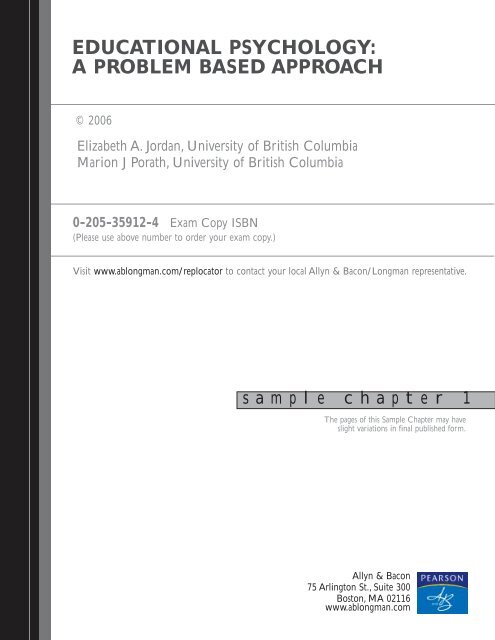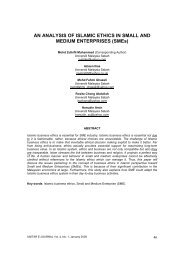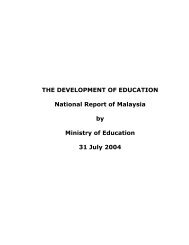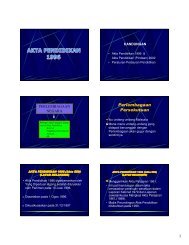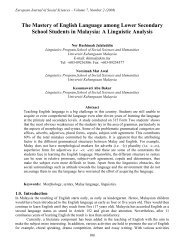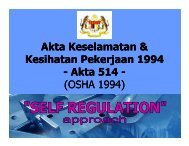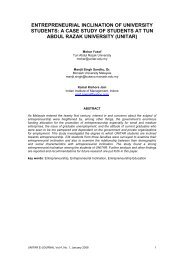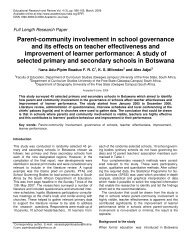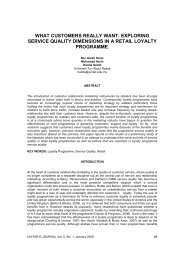educational psychology - Teo-Education.Com
educational psychology - Teo-Education.Com
educational psychology - Teo-Education.Com
You also want an ePaper? Increase the reach of your titles
YUMPU automatically turns print PDFs into web optimized ePapers that Google loves.
EDUCATIONAL PSYCHOLOGY:A PROBLEM BASED APPROACH© 2006Elizabeth A. Jordan, University of British ColumbiaMarion J Porath, University of British Columbia0-205-35912-4 Exam Copy ISBN(Please use above number to order your exam copy.)Visit www.ablongman.com/replocator to contact your local Allyn & Bacon/Longman representative.sample chapter 1The pages of this Sample Chapter may haveslight variations in final published form.Allyn & Bacon75 Arlington St., Suite 300Boston, MA 02116www.ablongman.com
<strong>Education</strong>al PsychologyCHAPTER21MotivationSupportive Classroom ManagementPhysicalSocialMoralEmotionalCognitiveLanguageDevelopmentTeaching<strong>Education</strong>alPsychologyLearningTheoriesIntelligenceCreativityEnvironmentClassroomStandardizedInterpretingAssessmentDiversityCultureSocietySpecial Special Needs NeedsWays Ways of Learning of LearningWelcome to the study of <strong>Education</strong>al Psychology. <strong>Education</strong>al <strong>psychology</strong>helps us understand learning and teaching and how development and differencesamong individuals influence the process of learning. Learning and teaching arehighly interrelated, and the study of <strong>educational</strong> <strong>psychology</strong> helps us makeinformed decisions about how our students learn best. It helps us reflect on ourown learning and, at the same time, informs our <strong>educational</strong> practice. As teachers1
2 <strong>Education</strong>al Psychology: A Problem-Based Approach www.ablongman.com/jordan1efaced continually with the complexities of professional practice, you will learnexactly how interwoven teaching and learning can be. In this chapter, we lay thegroundwork for your involvement with <strong>educational</strong> <strong>psychology</strong>.In this text we take a developmental approach to understanding how children andadolescents grow, change, and learn. Development is critical in the study of <strong>educational</strong><strong>psychology</strong>, and we discuss the topic from a variety of perspectives. Age andexperience affect children’s knowledge of and ways of engaging in academic subjects,social relationships, and moral dilemmas. Physical and emotional developmentalso affect children’s ways of understanding. Thus, teaching strategies need tobe responsive to the ways in which children and adolescents think about things.Teaching as Both Art and ScienceThere is a complex interrelationship between teaching and learning. The processof teaching is a combination of art and science. The art of teaching requires talent,creativity, flair, and intuition. A teacher must be attuned to other people andbe able to read emotions and feelings. He or she must be able to perceive thenuances of students’ reactions. At the same time, the science of teaching relies onreproducible knowledge that provides direction for instruction; in other words,teachers rely on the experience of others who have taught successfully. What hasworked for others, especially if backed up by the close scrutiny of research, givesus information on the teaching strategies that provide students with opportunitiesto learn. The learner is central to teaching.Too often, however, the learner is forgotten in the endeavor of learning to teach.This tendency is especially evident when we observe preservice or novice teachers.They are so busy with the act of teaching that they sometimes overlook the studentsthemselves. This is a natural and common occurrence when one is concentratingso hard on mastering a new skill. For example, most children are verycareless when learning to ride a bicycle. They are working so hard at riding the bikethat they forget about the cars and pedestrians sharing the street with them.Learning, on the other hand, tends to be a personal enterprise. No one elsecan learn something for you. When conditions for the learner are appropriate,learning can occur whether a teacher is present or not. Think of the number ofthings that you know about the world that you learned simply by watching a televisionprogram or observing someone else. There was no teacher present, andyet you learned something. Learning occurs naturally. The act of teaching buildson this innate capability and enhances learning. To facilitate the learningprocess, this book is designed not only to introduce concepts connected witheffective teaching and the influences affecting the learner, but also to help preserviceteachers understand the learner’s perspective. This understanding is vitalif you are to make the learner your primary focus in teaching.<strong>Education</strong>al Psychology: Theory and Practice<strong>Education</strong>al <strong>psychology</strong> is a discipline concerned with the overall teaching–learning process. Broadly defined, it can be separated into two distinct buthighly related areas: theory and practice. Throughout this book you will be
Chapter 1 <strong>Education</strong>al Psychology 3FIGURE 1.1Theory–Practice ContinuumTheoryPracticeintroduced to concepts that often have what appear to be two or more opposingviewpoints. In almost all instances, however, we urge you to think not in terms oftwo different, opposing frameworks, but rather in terms of two concepts oneither end of a continuum. <strong>Education</strong> is seldom a choice between two concepts;more often it is a compromise based on our knowledge of the learner, the contextof the learning situation, and the necessary learning goals. On the theory–practicecontinuum, a teacher can typically be found somewhere in the middle of thecontinuum, depending on the learner and the learning situation (Figure 1.1).Theory: A Scientific Frameworkfor Understanding LearnersPsychologists analyze what it means to be a human, whereas <strong>educational</strong> psychologists,with the use of theories and principles, analyze what it means to be alearner. These theories provide teachers with an understanding of the learner generalizedfrom many individuals’ experiences. From among the numerous theoriesthat exist, the teacher selects the concepts that most closely match the learner inquestion. The teacher then uses intuition (the “art” of teaching) combined withthe theory to achieve a better understanding of the unique learner and situation.In this way, theories are a critical part of the teaching process. For example, ateacher notices that a ninth-grade student is very concerned with comparing hismarks to others in the class. The teacher knows that social comparison theory willhelp her understand this, combined with talking to the student and his parentsto see if other pressures are affecting him. Or a grade 3 student is constantly seekingteacher attention, leading the teacher to question why the child is so needy. Isthe child emotionally and socially immature? Does she lack self-confidence? Hasshe had enough opportunities to experience mastery?Practice: <strong>Com</strong>bining Science with the Art of TeachingOn the other end of the theory–practice continuum, practice provides teacherswith a series of concrete strategies and activities that have proved to be effectiveteaching tools. Often these strategies and activities are handed down from practitionerswho have developed and tested their repertoires over years of experience—one of the reasons that a student teaching experience with a master teacher is soimportant (Photo 1.1). Master teachers create their repertoire from theoreticalbuilding blocks. They understand important theoretical concepts and use themto design instructional strategies that engage students and facilitate their academicachievement. The art of teaching can be learned only in a classroom, andit is learned most effectively with someone who shares a rich, well-informedrepertoire of experience.
4 <strong>Education</strong>al Psychology: A Problem-Based Approach www.ablongman.com/jordan1ePHOTO 1.1Student teachers learn most effectivelywith master teachers.Working along the Theory–Practice ContinuumThe development of a theory without any intention of putting it into practicemakes it nothing more than an interesting exercise in <strong>psychology</strong>. A commentsometimes heard in school staff rooms is that a teacher’s proven repertoire hasvalue, whereas theories are just for those in universities or “ivory towers”—notthose of us in the “trenches.” As one of the authors illustrates,“When my son was in grade 4, he was placed in the school’s Challenge Program. Welived in a very small community in which the local school was only kindergarten tograde 3, so when he changed to the larger elementary school we were delighted tosee this program for gifted students continuing. But soon my son started to “hide”by being very busy and quiet when it was time to leave his class to go to this program.He wanted no part of it. After talking to him, I met with the teacher whoworked with the Challenge Program to explain that all the children who came fromthe primary school had already completed the unit on magic that this teacher wasnow doing. The teacher explained that, although she knew some children hadalready completed the unit, she had already prepared the worksheets and materialsand was proceeding with teaching it. She noted that there wasn’t any additionalmaterial for the children to cover in this program. Her teaching assignment was aresult of scheduling, and she had had no opportunity to acquire an understandingof theories of giftedness. Such an opportunity would undoubtedly have made herapproach very different.”This example illustrates that both theory and practice are necessary for educationto function. Theory and practice interact to inform each other, and a teacherneeds to work back and forth along the theory–practice continuum to find thebest mix for a specific teaching–learning situation. Likewise, <strong>educational</strong> psychologistslearn a great deal from what happens in classrooms.As you work through the various theories of development and learning presentedin this text, you will quickly realize that no single theory can explain allthe variations that occur in the children and adolescents you encounter. Thedevelopmental approach we use in this text is actually a combination of manytheories, since human development is an open and complex dynamic system.The major challenge to developing a comprehensive theory is human natureitself.
Chapter 1 <strong>Education</strong>al Psychology 5PHOTO 1.2Classrooms are dynamic socialcommunities in which the particularmix of learners affects the learningthat takes place. We learn in bothsocial and individual ways. Classroomsare unique social communities, oftencalled communities of learners, thatcontribute to the development ofknowledge.Theory and Practice in the Classroom <strong>Com</strong>munityTheories help us grasp some of the nuances of human nature. Theories tend tobe succinct and based on the integration of a large research base. They provide uswith starting points to understand the learner as a human being and with ideasthat can be used to try to find the best fit between our teaching goals and thelearners in our classroom. Each learner is an individual with particular learningstyles and needs that must be taken into account in our teaching. Classrooms,however, are also dynamic social communities in which the particular mix oflearners affects the learning that takes place (Photo 1.2). We learn in both socialand individual ways. Classrooms are unique social communities, often calledcommunities of learners, that contribute to the development of knowledge.<strong>Com</strong>munity of Learners: The Social Constructionof KnowledgeWhat we learn is influenced both by our individual characteristics as learnersand by our interactions with others. Knowledge is socially constructed, a pointto which we will return in more detail. For now, we emphasize two points.■■Teachers are both learners and teachers. It is their responsibility to impartknowledge, but they do this most effectively when they learn from their students.If they learn how students understand the curriculum, for example,they can help students build on their current understanding to acquiremore complex forms of knowledge.Learners take on dual roles as well. This is an important corollary to the conceptof a teacher as both learner and teacher. In addition to the obviousrelationship between students and their teachers, students also learn intheir relationships with each other. Students are part of a community oflearners (see also Chapter 6). They learn from the experience of teachingeach other and working together on problems and projects. If teachers areopen to the experience, they also teach their teachers innumerable lessons.Detailing the teaching–learning experience and the variety of influencesthat bear on this experience is central to <strong>educational</strong> <strong>psychology</strong>.
Chapter 1 <strong>Education</strong>al Psychology 7Examples from Early ChildhoodThroughout the text, we include examples to illustrate key concepts of <strong>educational</strong><strong>psychology</strong>. These examples are intended to help you make the connectionsbetween <strong>educational</strong> psychological theory and practice. A number of theseexamples are from early childhood, such as the following from Vivian Paley’s(1981) book, Wally’s Stories. Wally highlights better than we can the reasons foremphasizing examples from early childhood.Wally: People don’t feel the same as grown-ups.Teacher: Do you mean “Children don’t”?Wally: Because grown-ups don’t remember when they were little.They’re already an old person. Only if you have a picture ofyou doing that. Then you could remember.Eddie: But not thinking.Wally: You never can take a picture of thinking. Of course not. (p. 4)Wally’s comments on thinking remind us that, as adults, we have forgotten alot about how we used to think when we were children. There is more of a gapbetween the thinking of adults and young children than there is between thethinking of adults and older children and adolescents. However, even at theselater periods of development, adults are sometimes challenged to understandhow older children or adolescents think. For example, a sixth-grader respondedin the following way to a question on a social studies test:Why is the Rhine River known as the “sewer of Europe”?Because Cologne is on the Rhine, and that’s where they make toilet water.Students rarely are being “smart.” They are genuinely trying to answer the questionthey thought you asked. Teachers need to ask what may have been meant by astudent’s response or action. By asking this question, you will become better preparedto think through the possible meanings of your students’ thoughts andactions during all stages of development.Examples from High School and CollegeWe also use examples from high school and college. As adults, we sometimes forgetwhat it is like to be a novice in a field or area of specialization. We often overlookthe struggles we went through in learning—and that these experiences oftenchanged the way we understand our world. In a college physics class, for example,Dykstra (1996) analyzed students’ discussions during a laboratory sessionon forces. After observing another student’s demonstration of forces cancelingout each other, Mike responds, “Okay, I see how what you’re saying can work. Itsure isn’t what I was thinking and I’m not sure it feels right, but I think I seewhat you mean” (p. 197). Mike’s comment illustrates how novices often dependon what “feels right” when solving scientific problems. They struggle when theysee evidence that is counterintuitive. Mike’s teacher listened to their conversationsto help students build scientific knowledge. When students reach the “I think I seewhat you mean” stage, they need opportunities to build solid understanding.They are starting to consolidate a concept; this is a perfect “teachablemoment.” Only by listening to what they are saying will you recognize thesemoments.In many instances you will find the examples from young children to beclearer than those from high school or college. This is because young childrentend to be more open socially when speaking or asking questions; the examples
8 <strong>Education</strong>al Psychology: A Problem-Based Approach www.ablongman.com/jordan1eare not complicated by subject area topics, and the social–emotional situationmay not be as complex. Throughout this book, however, we provide examples ofstudents from a range of ages to demonstrate that each age group has unique,yet related, challenges.Integrating <strong>Education</strong> and Psychology<strong>Education</strong>al <strong>psychology</strong> is considered to include “the development and applicationof psychological principles to education, as well as the adoption of psychologicalperspectives on education” (O’Donnell & Levin, 2001, p. 73). What willthis mean to you as a teacher? First, it is important to note that the relationshipbetween <strong>psychology</strong> and education is not unidirectional. While <strong>educational</strong> <strong>psychology</strong>has drawn on <strong>psychology</strong> to inform education, education has just asmuch to offer to <strong>psychology</strong>. <strong>Education</strong> offers the realistic learning and teachingsituations that challenge psychological theory (Mayer, 2001; O’Donnell & Levin,2001). It is in the real world that students and teachers engage in thinking andlearning. This is why <strong>educational</strong> <strong>psychology</strong> is meaningful to teachers. Mayer(2001) argued, “There is nothing as beneficial to practice as a good theory”(p. 87). Theory provides the conceptual underpinnings for teachers’ work. Sincethe early 1900s, <strong>educational</strong> <strong>psychology</strong> has been concerned with the followingtopics (O’Donnell & Levin):1. Measuring intelligence and relating intelligence to other variables (e.g.,gender and achievement)2. The reliability and validity of tests, the development of tests, and the evaluationof teaching3. Influences on learning, including different sorts of instruction and differentsorts of learning tools (e.g., types of text, computers)4. Teacher behavior (e.g., how teachers praise students, how teachersrespond to problem behaviors)5. The influence of motivation on learning6. Students’ attitudes, self-esteem, self-concept, and personality7. Students’ classroom behaviorSelf-Regulated LearningThe third and fifth topics in the preceding list can be expanded to includeresearch that has taken place since the 1970s on self-regulated learning (Paris &Paris, 2001). Self-regulated learning includes effective strategies for learning,reflection on one’s own thinking and learning (metacognition), and motivationand engagement with school tasks. The social support that studentsreceive in classrooms enhances self-regulated learning. Students who are selfregulatedtend to take charge of their learning. <strong>Education</strong>al <strong>psychology</strong>has been helpful in articulating the characteristics of self-regulated learnersand the classroom practices that support self-regulation and teaching selfregulatorystrategies.Classroom ManagementAn additional area of inquiry in <strong>educational</strong> <strong>psychology</strong> is classroom management.How teachers organize and manage classrooms is central to establishing
12 <strong>Education</strong>al Psychology: A Problem-Based Approach www.ablongman.com/jordan1eInfo Byte 1.1Since this text does not go into the specificdetails of many theories, it is necessaryfor you and your group to decidewhat theories might be the most relevantand then to research more details.In this book we give you Info Bytes toassist in your information searches. Byresearching theories in the library and onthe Internet, you will soon become efficientat looking up information. You willalso become selective consumers of thehuge amount of material at your disposal.The Internet will allow you toaccess information that is up to date andvalid, but this information is also meantto sell products or give global coverageto personal bias. As a teacher, you mustbe able to identify the information that isbased on solid research from reputablesources. The strategies used in this textwill allow you to practice these skills.Info Byte 1.2In addition to previews of relevant informationto help you find, or set, the problem,we have included lists, entitledSurfing Terms, to help you find more indepthinformation. They will help yousearch the Internet and library catalogues.The lists are not all-inclusive. Youoften will need to narrow your searches,since the terms sometimes target generalinformation about a topic.real. They represent the real world of teaching, with all its complexity, excitement,challenges, and unknowns. The problem-based learning strategy involvesworking in cooperative groups to think about the real world of teaching. Ingeneral, people seldom attempt to solve problems by themselves; instead,they usually ask others for information, opinions, and advice. By working ingroups, you will find that information searches are more manageable. Furthermore,the collaboration required in a group to find a possible or probablesolution reinforces and reflects the collaborative nature of the teachingprofession.Features of This TextThis text has two unique features. First, theory is presented the way we like toteach it—through stories of development, learning, and teaching. We all makemeaning of our lives through narrative (Bruner, 1986, 1996). Stories reflect individuals’construction of the meaning of events in their lives. Teachers spend agreat deal of their professional lives in the “narrative mode” (Bruner, 1986), bothlistening to their students’ stories and telling and retelling their own as they tryto understand their practice.Theory-Based NarrationIn each chapter, narrative-style text introduces you to relevant theory by presentingkey theoretical concepts and examples of what these concepts mean in thereal world. Consistent with a problem-based approach to learning, the presentationof theoretical concepts contains key information, but does not includeexhaustive detail. To supplement the theory-based narration, we have includedfeatures called Info Bytes and Surfing Terms. These features provide additional relevantinformation to help you to find and set the problem and also to expandyour ideas on how to solve the problem.At the end of each of the following chapters, you will find a section called AMetacognitive Challenge. This is your opportunity to synthesize the informationyou have learned. In Chapter 4 you will learn more about metacognition and discoverwhy this section has the title it does. This section contains questions thatprovoke personal reflection.Problem-Based ScenariosSecond, problem-based scenarios reinforce principles of theory by introducing youto teachers, students, parents, principals, and other school personnel. Many ofthese scenarios contain two parts: the first describes the context, and the second isa collection of artifacts such as might be contained in a folder on a teacher’s desk:memos, student work samples, test results, and the like. Only some of the scenarioscontain artifacts, since it is often the case that teachers are confronted withissues that are immediate and for which no relevant data have been gathered.The problem-based scenarios are situated in elementary, middle, and secondaryschool contexts. Also, some narratives focus on students with special <strong>educational</strong>needs. Each narrative is coded with an icon to identify the particular context(Figure 1.2).Because development, learning, and teaching are multifaceted, you will revisitvarious students and teachers as you move through the different topics in thebook. For example, the first time you meet a student, his or her teacher may befocused on a cognitive developmental question to meet academic needs. Later you
Chapter 1 <strong>Education</strong>al Psychology 13K-5Elementary school narrative6-8Middle school narrative9-12Secondary school narrativeFIGURE 1.2Icons Used in Problem-BasedScenariosSpEdProblem-based scenario that focuses on theconsideration of special learning needs in aregular classroommight learn more about that student’s motivation, peer relationships, and familylife to determine how a teacher might help this student function successfully atschool. Problem-based scenarios demonstrate the interconnectedness of differentfacets of development, learning, and teaching.Using the Problem-Based ScenariosIn many instances, you will find that a topic is introduced but omits the lengthydetail often found in <strong>educational</strong> <strong>psychology</strong> texts. One goal of problem-basedlearning is for you, as the student, to detail not only the problem, but also the typeof information necessary for its solution. For each problem-based scenario, youwill need to actively engage in setting (defining) the problem and then determiningwhere and how to gather the necessary information related to your focus ofaction.The first several scenarios in this text provide additional help in the form ofquick questions and hints to focus you on the problem to be solved. For example,suppose a sixth-grade teacher noticed that one of his best students, Peter,began to turn in incomplete work and appear disinterested in school. Severalquestions need to be considered. Is this a motivational issue (Peter isn’t challengedenough), a hearing problem (perhaps made worse by a severe cold), aresult of peer influence, an indication of an emotional issue at home, or someother cause? Teachers talk to each other, offer advice on where to find information,and swap articles and addresses. In other words, they work together as a collaborativeunit, gathering and analyzing information to find probable andpossible solutions.Focus on the ClassroomTeachers often consider students’ development on an individual basis. But italso is the case that a teacher needs to consider student needs within the contextof all the learners in the classroom. Some chapters conclude with classroom scenariosin which the learners you met earlier in the book join their classmates.These scenarios challenge you to apply principles of <strong>educational</strong> <strong>psychology</strong> to
14 <strong>Education</strong>al Psychology: A Problem-Based Approach www.ablongman.com/jordan1emeeting individual needs within the classroom setting. Teaching is both achallenging and a rewarding profession. It requires hundreds of decisions a day,and these decisions often involve consideration of a variety of factors. <strong>Education</strong>al<strong>psychology</strong> will help you make informed decisions. It also will add to theexcitement of teaching by giving you new frameworks for interpreting students’thoughts and behaviors. Ultimately, we hope that the use of <strong>educational</strong> <strong>psychology</strong>leads you to innovative practice and engaged learners—two invaluablerewards of the profession.


